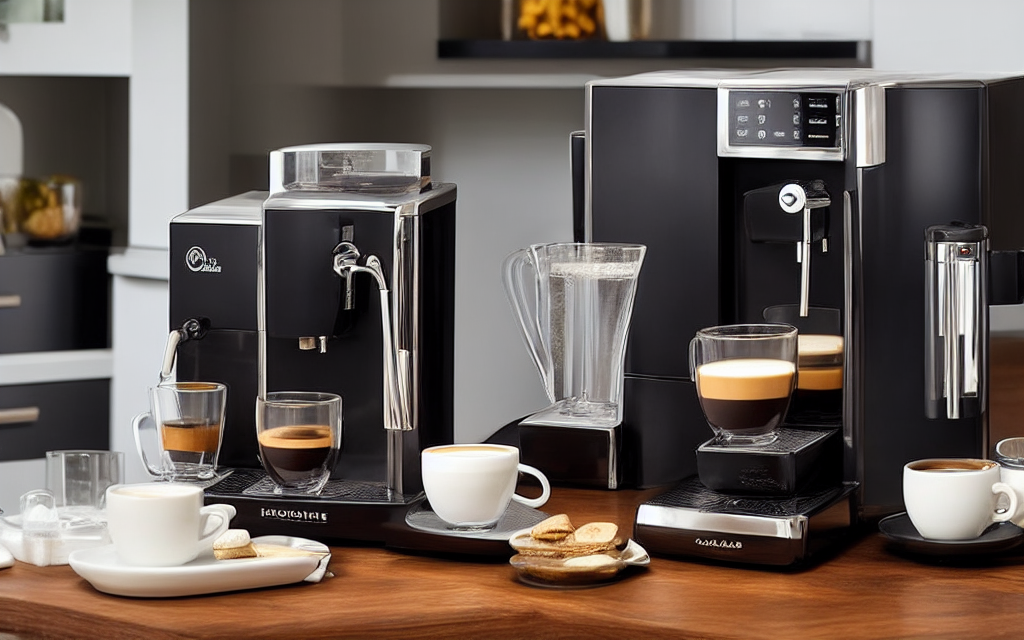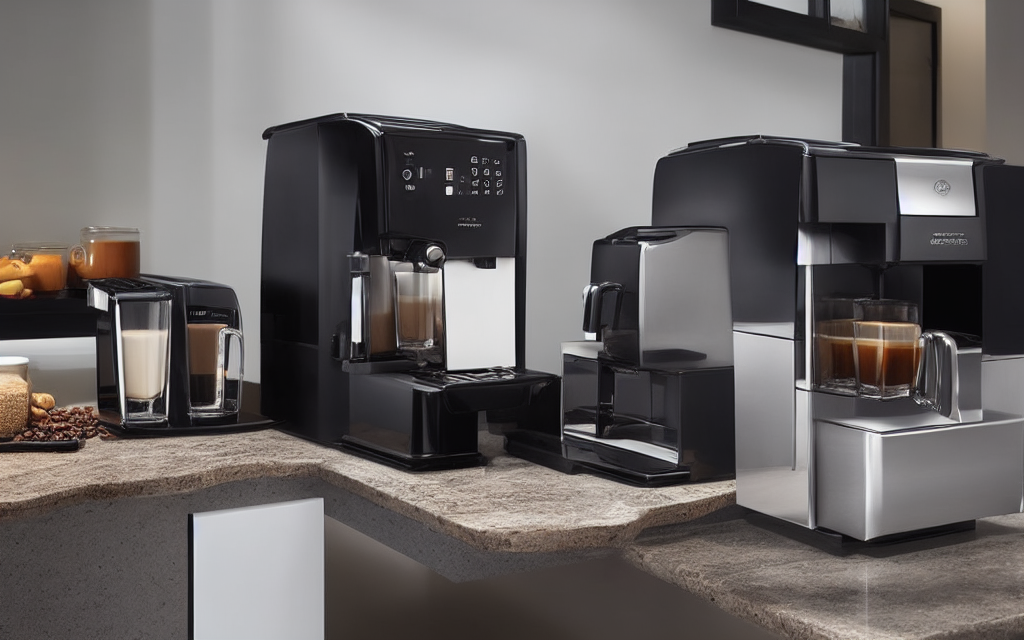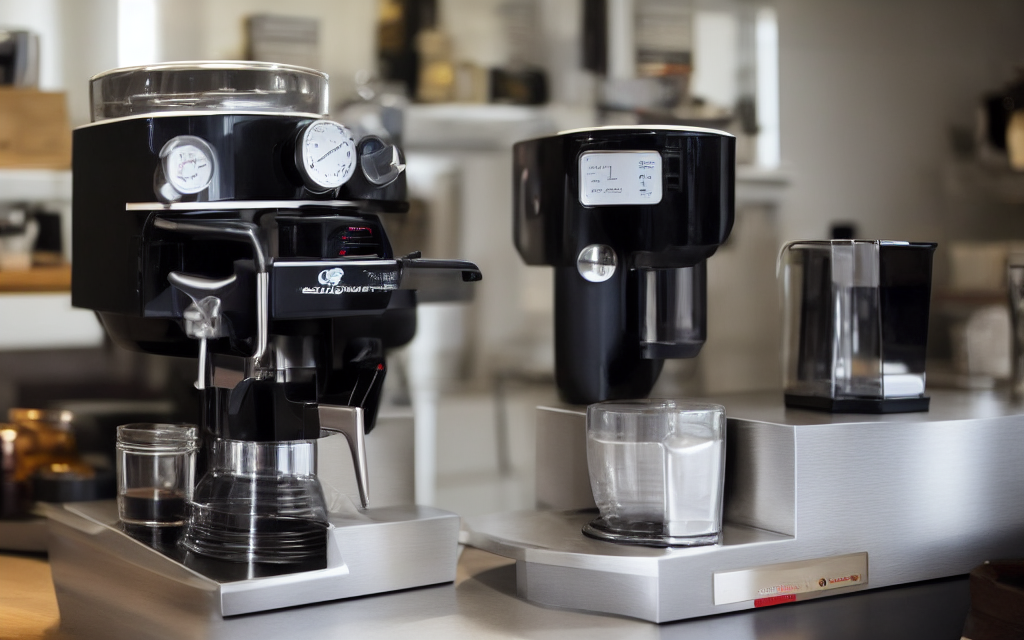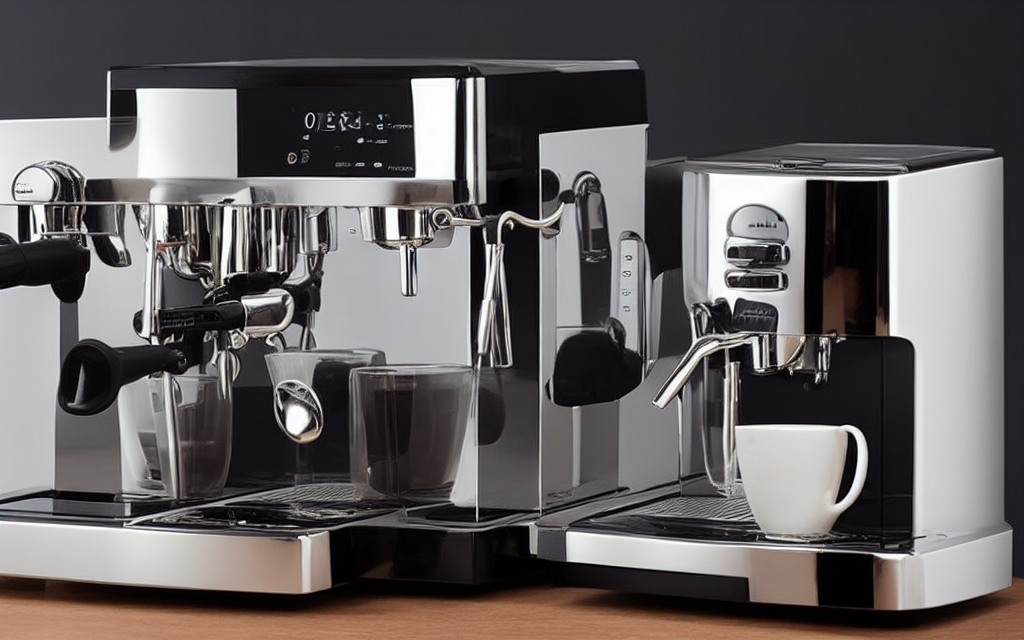Professional Espresso Machine for Home: Your Guide to Café-Grade Coffee at Home
Tired of lukewarm coffee settling in your travel mug? Dreaming of the rich, velvety crema that baristas pour with effortless grace? You're not alone. The desire for professional-grade espresso in the comfort of your own kitchen has fueled a booming market of high-end espresso machines designed specifically for home use. But with brands like La Marzocco, Slayer, and Gaggia boasting prices that would make your wallet weep, how do you navigate the world of professional espresso machines for home use?
Sponsored placement reserved
Configure project monetization rules or AdSense slot IDs to activate this position automatically.
The good news? Home doesn't have to mean compromised quality. Thanks to technological advancements and a growing demand for premium coffee experiences, professional espresso machines for home use have never been more accessible or impressive. These machines aren't just scaled-down versions of commercial giants; they're purpose-built workhorses engineered to deliver barista-level performance right in your kitchen.
In this comprehensive guide, we'll dive deep into everything you need to know about professional espresso machines for home use. From understanding the key components that make a machine "professional-grade" to exploring top models that have earned the loyalty of discerning coffee enthusiasts worldwide, we've got you covered. We'll also address crucial considerations like space requirements, plumbing needs, and maintenance routines to ensure you're fully prepared for your café-grade coffee journey.
Level Up Your Know-How
Get actionable frameworks, checklists, and templates delivered every Monday to keep your skills sharp.
We respect privacy. Unsubscribe anytime.
What Makes an Espresso Machine Professional?
The term "professional espresso machine" can be misleading. While baristas and café owners often use machines from brands like Slayer, La Marzocco, and Gaggia, not all machines in these price brackets are identical. Understanding the key differentiators between a professional-grade machine and its consumer counterparts is essential before making a significant investment.
Professional espresso machines for home use typically feature thicker, more durable boilers that can handle multiple simultaneous hot water flows without pressure drops. These robust boilers usually heat water using a thermoblock system, which provides rapid heating and cooling cycles – a crucial feature for professional environments where machines operate continuously.
Another defining characteristic is the precision in temperature and pressure control. Professional machines often feature PID (Proportional Integral Derivative) controllers that allow for precise temperature regulation. This level of control ensures consistent extraction every single time, eliminating the shot-to-shot variation that can plague lower-end machines.
Pressure profiling is another critical feature. Unlike traditional machines with fixed pressure during extraction, professional machines allow you to shape the extraction profile – increasing pressure during the first half of the shot and decreasing it during the final third. This capability dramatically improves coffee flavor development and reduces bitterness.
The group head design also differs significantly. Professional machines typically feature a solid, thermally insulated group head that houses the portafilter. This design minimizes heat transfer to the brew chamber, ensuring consistent water temperature throughout the extraction process. Some models also feature dual group heads, allowing simultaneous brewing – a feature highly prized in commercial settings but less common in home machines.
When considering a professional espresso machine for home use, you must also consider the steam boiler. High-end machines often feature two separate steam boilers – one for steam wand texturing and one for water brewing. This separation ensures that using the steam wand doesn't affect the water temperature for brewing, a critical consideration for serious espresso enthusiasts.
The pump is another crucial component. Professional-grade machines typically feature high-horsepower pumps capable of delivering 15-20 bars of pressure consistently. These pumps are designed for continuous operation, unlike consumer-grade pumps that may overheat or lose pressure quickly with extended use.
Finally, the build quality speaks for itself. Professional machines are constructed from thicker gauge stainless steel, with attention to detail in every component. This robust construction ensures longevity – many professional machines lasting 10-15 years with proper maintenance, far exceeding the typical 5-7 year lifespan of consumer models.
Top Professional Espresso Machines for Home Use
The market offers several exceptional professional espresso machines suitable for home use. Each brand brings its unique strengths and features to the table. Let's explore some of the top contenders that have earned the loyalty of professional baristas and discerning home enthusiasts alike.

Top Professional Espresso Machines for Home Use
La Marzocco Bros Artisan V2
Often considered the benchmark for professional home espresso machines, the La Marzocco Bros Artisan V2 combines commercial-grade performance with thoughtful home features. This American-style machine boasts a massive 8-liter thermoblock for unparalleled heating and cooling speed, a powerful 16-bar pump, and a unique brewhead system that allows for adjustable brew pressure.
One of the standout features of the Artisan V2 is its counterbalance system, which eliminates the need for a heavy portafilter handle during extraction – a significant ergonomic advantage. The machine also features a direct steam wand access, allowing for precise milk texturing without awkward angle adjustments.
For those with limited space, the Artisan V2's compact footprint (designed with the iconic "Little Italy" model in mind) makes it surprisingly space-efficient for its capabilities. At around $4,500, it represents a significant investment, but many owners consider it a lifetime purchase due to its durability and performance.
Slayer Espro P6 Plus
The Slayer Espro P6 Plus has earned a dedicated following among home baristas and competitive coffee champions. Its unique "Pressure Profiler" system allows for precise control over extraction parameters, making it a favorite among those seeking perfect shot consistency.
What sets the P6 Plus apart is its innovative brewing technology. The machine features a patented system with six precisely engineered holes in the portafilter that ensures consistent water distribution and pre-infusion for every shot. This attention to detail makes it a standout among pressure profiling machines.
The P6 Plus also features Slayer's proprietary BrewSentry system that automatically adjusts brew pressure based on coffee dose, eliminating the guesswork for perfect extraction. With its robust construction, powerful 16-bar pump, and excellent temperature stability, the P6 Plus delivers café-quality espresso consistently. Priced around $3,500, it represents excellent value for those seeking professional-grade performance.
Gaggia Classic Premium
For those seeking authentic Italian-style espresso with professional results, the Gaggia Classic Premium delivers. This machine captures the essence of traditional commercial Italian design while incorporating modern performance enhancements.
The Classic Premium features a powerful 19-bar pump, a large 2-liter boiler, and a distinctive lever-style brewhead reminiscent of traditional Italian machines. While it may lack some of the advanced digital controls found on higher-end machines, its simplicity makes it approachable for coffee enthusiasts of all experience levels.
One of the standout features is the robust steam boiler that provides ample steam for milk texturing while maintaining stable brewing temperatures. The machine's sturdy construction and reliable performance have made it a favorite in countless home baristas' setups worldwide. Priced at approximately $2,200, it offers impressive value for money.
Breville the BES870 Commercial Plus
For those seeking professional features without the premium price tag, the Breville BES870 Commercial Plus provides an excellent alternative. This machine incorporates many professional-grade features into a more affordable package.
The Commercial Plus boasts a commercial-style thermoblock, a 15-bar pump, and PID temperature control – features typically found on machines costing significantly more. It also features a large 1.7-liter boiler for rapid heating and cooling cycles, ideal for high-volume home use.
One of the standout features is the dual-function steam wand, allowing for precise milk texturing without affecting the brewing boiler. The machine also includes programmable shot volume settings and a pre-infusion function to ensure consistent extraction. At around $1,500, it represents an exceptional value option for those seeking professional-grade features.
Jura Impressa F9
Catering to those who value convenience alongside professional performance, the Jura Impressa F9 offers a compelling combination of features. This machine incorporates many professional elements into an all-in-one package designed for home comfort.
The Impressa F9 features a commercial-style 1.7-liter boiler, a 15-bar pump, and a PID-controlled boiler for precise temperature management. It also includes an integrated grinder capable of producing fine espresso grind consistently. The machine's automatic dosing system measures coffee precisely for each shot, eliminating guesswork.
For those who appreciate convenience, the Impressa F9 offers programmable shot settings, automatic steam milk texturing, and even a built-in frothing pitcher. The machine's intuitive interface and comprehensive feature set make it an excellent option for those seeking professional results without the complexity of manual operation. Priced at approximately $2,80 (MSRP), it offers a more accessible entry point into professional-grade espresso.
Key Considerations Before Buying
Investing in a professional espresso machine is a significant commitment, both financially and in terms of space. Before making your purchase, several crucial factors warrant careful consideration to ensure you select the right machine for your specific needs.
Space Requirements
Professional espresso machines are substantially larger than consumer-grade models. Most machines require dedicated counter space measuring 30-40 inches in width and at least 27-30 inches in depth. Before purchasing, carefully measure your available space, considering not just the machine itself but also room for accessories like a dedicated grinder, scale, thermometers, and potentially a dedicated sink and disposal.

Space Requirements
Placement is another critical consideration. Most professional machines require a minimum of 3 inches clearance on all sides for proper ventilation and heat dissipation. Some models may require additional clearance above the machine to prevent steam vent issues. Consider ceiling height as well – machines with large boilers may require significant overhead clearance.
For those with limited counter space, look for machines with compact designs or consider under-counter refrigerated cabinets to extend usable space. Some models also offer smaller footprint options, though they typically sacrifice capacity for space savings.
Plumbing Requirements
Professional espresso machines require dedicated plumbing setups significantly different from standard kitchen faucets. Unlike regular aerators, these machines require specialized water filtration and pressure specifications. Most models require a minimum water pressure of 40-60 PSI, which many home water systems may not provide naturally.
Professional-grade machines also require a substantial water supply line – typically 1/2 inch diameter (5/8 inch recommended) – to support the high flow rates needed for optimal performance. Most machines require a dedicated 5/8 inch water line and a separate drain line for used water, though some models offer quick-connect adapters for easier installation.
Water temperature is another critical factor. Professional machines typically require water temperatures between 170-185°F (77-85°C) for optimal brewing. Some models feature internal water heaters to ensure consistent temperature regardless of incoming hot water supply, while others rely on the home's existing water heater.
Maintenance Requirements
Professional espresso machines demand more rigorous maintenance than consumer models. Unlike basic drip coffee makers, these machines require regular descaling with specialized solutions specifically formulated for espresso boilers, not generic dishwasher cleaners.
Most professional machines require at least annual professional servicing to ensure optimal performance. During this maintenance, technicians typically clean internal components, check seals, calibrate pressure, and perform other tasks unavailable to owners. Consider shipping costs and technician availability, especially for premium brands.
Daily maintenance includes wiping down the machine, cleaning the portafilter and group head after each use, descaling monthly (or more frequently in hard water areas), and ensuring proper storage when not in use. Some models feature automatic shut-off during steaming to prevent scorching, but manual intervention is still necessary for proper maintenance.
Budget Considerations
Professional espresso machines represent a substantial investment, with prices ranging widely based on features, brand, and quality. Entry-level models start around $1,500, while high-end machines can easily exceed $5,000. Many consider these investments to be "lifetime purchases" due to their durability and performance, but be prepared for ongoing costs.
Beyond the initial purchase price, factor in additional costs:
Advanced Tips for Home Espresso Mastery
Once you've selected your professional espresso machine, the journey to mastering café-quality espresso begins. Even with the best equipment, without proper technique and knowledge, you won't achieve consistent, professional-grade results. Here are some advanced tips to elevate your home espresso game.
Understanding Extraction Parameters
Professional baristas measure extraction with precision, often timing the shot to ensure proper brewing. A standard single shot should deliver approximately 30ml of liquid in 25-30 seconds, yielding an extraction ratio of 1:2 to 1:2.5. Mastering this requires practice and attention to detail.
The golden ratio – the relationship between coffee dose and yield – is crucial for consistent extraction. A general starting point is 1:2, adjusting based on your coffee's density and desired strength. Use a scale to measure both dose and yield precisely. Note that grams matter far more than "coffee spoonfuls."
Brew temperature dramatically impacts extraction quality. The ideal brewing temperature ranges between 195-205°F (90-96°C). Use an infrared thermometer to monitor both boiler temperature (controlled by PID) and actual brew water temperature. Temperature inconsistencies are a common cause of under or over-extraction.
Water Quality and Filtration
Professional baristas are often more concerned with water quality than coffee selection. Hard water (high mineral content) can damage boilers and affect extraction, while soft water may under-extract even with high-quality beans.
Most professional machines require filtered water specifically designed for espresso. Install a dedicated whole-house water filtration system if your municipal water quality is poor. Alternatively, use a dedicated machine-specific filter designed for espresso machines, which remove chlorine and other contaminants while preserving beneficial minerals.
The TDS (Total Dissolved Solids) meter measures the mineral content in your water. Professional baristas typically aim for a TDS reading between 150-250 ppm for optimal extraction. Most home TDS meters cost under $100 and provide valuable feedback on water quality.
Grinder Calibration and Technique
The grinder is arguably the most important component in the home espresso setup beyond the machine itself. Professional baristas spend significant time calibrating their grinders for each coffee. Start by identifying the appropriate grind size for your machine and coffee. For most espresso, a grind setting between 8 and 10 on a 0-20 scale is suitable, though this varies significantly between grinder models.

Grinder Calibration and Technique
Consistency is key – professional baristas aim for minimal variation between grinds. This requires regular calibration and cleaning of your grinder. Most professional grinders allow for micro-adjustments, enabling precise calibration for specific coffee varieties.
Dosing and distribution dramatically impact extraction. Practice your tamping technique – level the grounds in the portafilter, apply even pressure, and avoid compaction. Use a scale to measure coffee dose precisely, and practice your distribution – ensuring even water flow through the grounds.
Milk Texturing Mastery
Perfectly textured milk is another hallmark of professional espresso service. Achieving velvety microfoam requires understanding milk properties and proper technique. Use whole milk for the best results – skim and almond milk dramatically alter texturing properties.
Steam wand temperature dramatically impacts milk texture. The ideal temperature for steaming milk ranges between 150-160°F (65-71°C). Overheating destroys delicate milk proteins, while underheating results in poor texture. Practice submerging the wand in the milk before introducing it to the surface to warm the milk uniformly.
Texturing begins with proper wand technique. Insert the wand tip at a 45-degree angle, creating a vortex as you submerge the wand. Once at the surface, rotate the wand in a circular motion to create microfoam. Listen for the transition from sizzle (coarse bubbles) to soft popping (fine bubbles).
Troubleshooting Common Issues
Even with careful setup and maintenance, professional espresso machines may occasionally encounter issues. Understanding common problems and their solutions can save time and money. Here are some troubleshooting tips to help you navigate challenges.
Pressure Issues
Low pressure during extraction can dramatically impact shot quality. First, check the machine's power cord and circuit breaker – many machines require dedicated circuit protection. Ensure the machine is properly grounded and not overloaded on your home circuit.
Next, check for blockages in the brew group. Sometimes coffee grounds or scale deposits can partially obstruct water flow. Use a paperclip or specialized tool to gently clear any visible obstructions, being careful not to damage delicate components.
If the issue persists, check water pressure and flow rate. Some machines allow you to adjust the internal pressure switch, though this should be performed by a qualified technician. A failing pump may require professional repair or replacement.
Temperature Inconsistencies
Fluctuating brew temperatures can dramatically affect extraction consistency. First, check the PID settings – ensure the machine is set to control boiler temperature rather than group head temperature. Most professional machines allow you to switch between these modes.
Verify your water temperature with an infrared thermometer. If temperatures vary significantly between shots, the issue may be scale buildup in the thermoblock or group head. Regular descaling can prevent this issue, but existing buildup may require professional cleaning.
Check for proper pre-infusion. Some machines feature automatic pre-infusion, while others require manual activation. Insufficient pre-infusion can lead to channeling and temperature inconsistencies. Consult your machine manual for specific instructions.
Steam Boiler Problems
Steam boiler issues typically manifest as poor milk texturing or complete steam function failure. First, check the water level in the machine – many models have an indicator light if the water level is too low.
Next, verify steam pressure. A properly functioning steam boiler should deliver approximately
Sponsored placement reserved
Configure project monetization rules or AdSense slot IDs to activate this position automatically.
